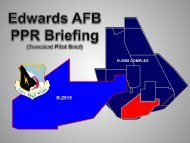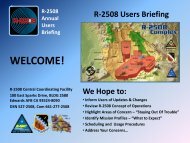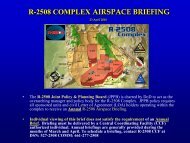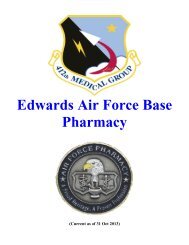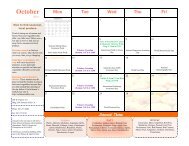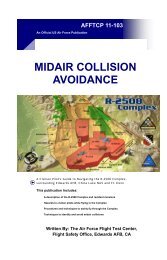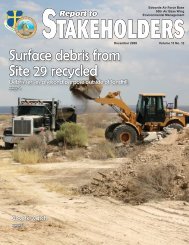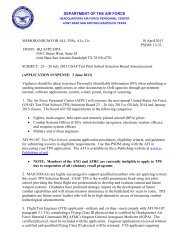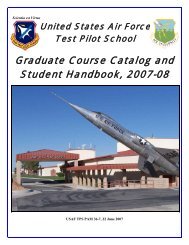AF Plant 42 AICUZ Study - Feb. 2012 - Edwards Air Force Base
AF Plant 42 AICUZ Study - Feb. 2012 - Edwards Air Force Base
AF Plant 42 AICUZ Study - Feb. 2012 - Edwards Air Force Base
Create successful ePaper yourself
Turn your PDF publications into a flip-book with our unique Google optimized e-Paper software.
3.0 LAND USE COMPATIBILITY GUIDELINES<br />
3.1 Introduction<br />
The DoD has studied landuse<br />
compatibility in the<br />
vicinity of its airfields<br />
since the end of World<br />
War II. One of the first<br />
efforts was in 1952 when<br />
the President's <strong>Air</strong>port<br />
Commission published<br />
"The <strong>Air</strong>port and Its<br />
Neighbors", better known<br />
as the "Doolittle Report".<br />
The recommendations of<br />
this study were influential<br />
in the formulation of the<br />
APZ concept.<br />
The <strong>AICUZ</strong> Program was<br />
developed in response to<br />
increased urban<br />
encroachment around<br />
military airfields. Most <strong>Air</strong><br />
<strong>Force</strong> installations were<br />
built in the late 1940's and<br />
early 1950's in locations 10<br />
to 15 miles away from<br />
urban population centers<br />
during an era of propeller<br />
aircraft. Since then, the<br />
nature of aircraft has<br />
changed, notably with the<br />
development of the jet<br />
engine. Urban growth has<br />
gradually moved closer<br />
towards the boundaries of<br />
many <strong>Air</strong> <strong>Force</strong><br />
installations. Incompatible<br />
land use often results in<br />
public complaints about<br />
the effects of aircraft<br />
operations (e.g., noise and<br />
low overflights). Frequent<br />
complaints can cause<br />
operational changes,<br />
which in many cases<br />
adversely affect the flying<br />
mission. As an example,<br />
encroachment around<br />
Lowry, Chanute and<br />
Laredo <strong>AF</strong>Bs contributed<br />
to the decision to cease<br />
aircraft operations at<br />
those installations.<br />
The DoD developed the <strong>AICUZ</strong> Program to protect aircraft<br />
operational capabilities at its military airfields and to assist local<br />
government officials in protecting and promoting the public health,<br />
safety, and quality of life. The goal of the program is to promote<br />
compatible land use development around military airfields by<br />
providing information on aircraft noise levels and accident<br />
potential.<br />
<strong>AICUZ</strong> reports describe three basic types of constraints that affect<br />
or result from flight operations. The first constraint involves areas<br />
identified by the FAA and DoD where height limitations on<br />
structures exist to prevent obstructions to air navigation. <strong>Air</strong>space<br />
Control Surface Plans, which are based on Federal Aviation<br />
Regulations, designate height standards that determine whether an<br />
object constitutes an obstruction to air navigation.<br />
The second constraint regarding flight operations involves the<br />
potential effects arising from noise exposure resulting from aircraft<br />
overflight and ground engine runs. Detailed sociological studies<br />
conducted by federal agencies over the past few decades have<br />
shown a correlation between certain noise exposure levels and<br />
increased levels of human annoyance. One of the purposes of the<br />
DoD <strong>AICUZ</strong> Program is a comparison of the land uses in the<br />
vicinity of its airfields to noise zones. Using the NOISEMAP<br />
computer program, which is similar to FAA's INM, the DoD<br />
produces noise contours showing the DNL that would be generated<br />
by current levels of aircraft operations. These contours (lines<br />
connecting points of equal noise exposure) are expressed in terms<br />
of the DNL. Essentially, the DNL metric is the average noise level<br />
over a 24-hour period with a 10 dB increase made for events<br />
occurring between 10 PM and 7 AM. In California, a 5 dB<br />
increase is added to aircraft flights that occur between 7 PM and 10<br />
PM and a 10 dB increase is added to aircraft flights that occur<br />
between 10 PM and 7 AM to account for their increased<br />
annoyance. This <strong>AICUZ</strong> report contains noise contours plotted in<br />
increments of 5 dB, ranging from a DNL of 65 dB to 80+ dB.<br />
Additional information on the methodology used for analyses in<br />
this report is contained in Appendix C of Volume II.<br />
The third constraint involves accident potential in areas near the<br />
runways based on statistical analyses of past DoD aircraft<br />
3-1



